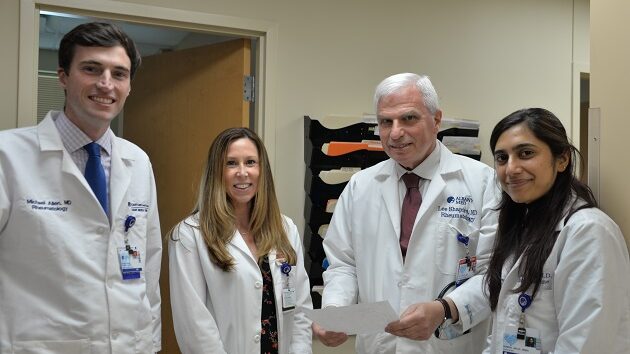Scleroderma Clinic Offers Expertise – and Reassurance

Chris’s symptoms did not begin all at the same time: First it was joint pain and discomfort. Then she was excessively tired, sleeping more than ten hours a night and napping another hour or two during the day.
She developed foot pain and acid reflux. Within six months, her hands and feet were suddenly and unpredictably turning white, a symptom of Raynaud’s phenomenon.
Eventually, blood work and other tests revealed she had scleroderma – a disease she had never even heard of before.
Rare Autoimmune Disease
Scleroderma is a chronic autoimmune disease that causes a hardening and tightening of the skin and connective tissues. This can lead to a wide array of symptoms, including thickening skin, incontinence and other gastrointestinal issues, joint pain, and sores on fingers. It can also affect the lungs, kidneys, heart, and other internal organs, and, in the worst cases, can cause organ failure.
“Scleroderma is like a multilane highway, but where people tend to stay in their lane,” explained rheumatologist Lee Shapiro, MD, director of Albany Medical Center’s scleroderma clinic, a Designated Scleroderma Research & Treatment Center, and chief medical officer of the Steffens Scleroderma Foundation.
He added that for some, the disease never goes far or fast, while for others, it progresses very quickly.
According to the National Scleroderma Foundation, more than 300,000 Americans live with some type of scleroderma. There is currently no cure, but treatments can reduce symptoms and damage from the disease, as well as slow its progress.
June is Scleroderma Awareness Month.
Collaboration
“Scleroderma can come out in different ways in different people, and can take a long time to diagnose,” said rheumatologist Michael Allen, MD.
Together, Drs. Shapiro and Allen, their nursing and administrative teams, and a range of specialists including pulmonologists, nephrologists, gastroenterologists, cardiologists, and occupational therapists, care for several hundred scleroderma patients.
“We build relationships with our patients,” Dr. Allen said. “By the time they come to us, they’ve often seen many providers, so it’s reassuring to them to know that this clinic exists and that we’ll manage their care and coordinate with all their other specialists.”
A clinical pharmacist, Jessica Farrell, PharmD, is also a key part of the team.
She scrutinizes potential drug interactions, advises patients on how and when to take medications, answers questions about the long-term impact of their drug treatments, and addresses any other concerns related to their medications. She also often works with insurance providers to get patients access to the medications they need.
Reassurance
One of the first things the doctors often address with new patients is anxiety about the disease. “For many years, there were no effective treatments and scleroderma had a very dark reputation,” Dr. Shapiro said.
Now, new therapies and treatment options can help patients manage their symptoms and sometimes even get better.
Eight years ago, a farmer Dr. Shapiro treated for scleroderma developed shortness of breath from pulmonary hypertension, a potentially fatal disease complication for which until recently there was no treatment. Now there are many medications, and the farmer is still farming, his treatment directed by pulmonologist Boris Medarov, MD, with whom Drs. Shapiro and Allen closely collaborate.
“In a previous era, he would be housebound at best,” said Dr. Shapiro.
In addition, Dr. Farrell noted that medications used to treat anxiety can also be used to treat some symptoms of scleroderma. The clinic also coordinates care with mental health professionals who specialize in autoimmune diseases.
Research and Clinical Studies
Providers at the scleroderma clinic also actively participate in research and clinical studies.
“One of the most serious and grave complications of scleroderma is scleroderma renal crisis, which can be a life-threatening complication of the disease,” said Swati Mehta, MD, a nephrologist who sees scleroderma patients at Albany Medical Center’s Nephrology clinic.
While scleroderma renal crisis is most often seen within the first five years of a diagnosis, it can occur later in the course of the disease. Dr. Mehta is currently leading a multi-center study to identify how often this happens, and the clinical characteristics of these patients.
Dr. Mehta’s research also explores other types of kidney disease in scleroderma patients and potential new treatment options, including the use of C5 inhibitor drugs.
“Understanding the complexities of kidney disease in scleroderma can help improve patient outcomes and is key to better understanding the disease itself,” said Dr. Mehta.
Hope
Today, Chris takes medications to help control her acid reflux and Raynaud’s. “Now they’re just an inconvenience,” she said.
She added that although she’s not sure what the future will hold, she feels lucky she was diagnosed so quickly – and locally. “I was prepared to go back to Long Island, where I still have family, for appointments and treatments,” she said. “But instead, I can get all my care here, ten minutes from my home.”
Drs. Shapiro and Allen see adult scleroderma patients at the Malta Specialty Care Center at Saratoga Medical Park, 6 Medical Park Dr., Suite 203 in Malta. Dr. Allen also sees scleroderma patients at the Rheumatology clinic at 99 Delaware Ave. in Albany. To schedule an appointment, call 518-264-1200 (Malta office) or 518-262-5345 (Albany office).